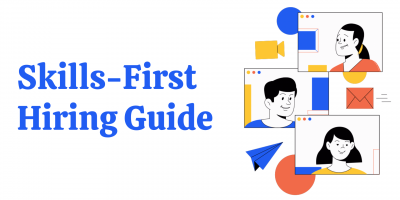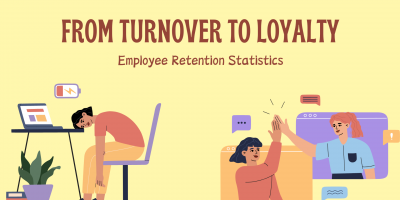
Is the Job Market Bad Right Now?
In the face of a slowdown in hiring, sweeping policy changes, economic uncertainty, and an increase in ghost jobs, securing employment seems more challenging than ever. However, there may still be a silver lining.

Attracting top talent is a pivotal step in forging a company’s success. The company that recruits and retains the most talented job seekers is bound to have an advantage over the rest. As pages like Glassdoor become increasingly popular, potential hires can get in-depth ratings, reviews, and experiences of any company they are considering applying for, hence why employers need to consider their employer brand.
Simply put, employer brand refers to an organization’s reputation, its character, and its identity as a place of employment. It’s the lens through which its current employees, potential employees, the public, and everyone else perceives it.
Employer branding is a unique approach and strategy to make companies stand out and show how they are different from the rest when competing for the same talent pool.
Employers need to consider their brand long before they start the recruitment process, as simply posting a job opening will not attract many qualified applicants. It’s their online presence, social media, and website that applicants are interested in.
They want to hear employee stories, testimonials of workers, why other people work there, or in other words, how this job will bring them fulfillment.
Strong and effective branding gives employees a genuine and authentic preview of what it would be like to work in the company and how they would fit into the workplace. Every decision as an employer leaves an impression that shapes the brand.
When employees are treated well, they become brand ambassadors attracting skilled candidates through employee referrals. Not only does this boost a company’s brand, ensures the candidate is a good fit culture-wise, but it also helps cut down the time to fill positions.
Everything that an organization puts out reflects its brand, company culture, and values.
Without proper management, it can become a dealbreaker for prospective employees and negatively impact the talent pipeline. According to Harvard Business Review, companies that have a negative reputation must spend 10% more on every hire. Although employers cannot dictate their brand, they can learn how to cultivate it and hopefully position themselves as a great employer in the public view.

We have already established that companies have an existing brand and image, regardless or not if they pay any attention to it. Employer branding cannot be controlled or run, but there are some effective strategies that employers can do to influence it.
The first stage of an effective branding strategy starts with defining the organizational strategy, objectives, and workforce planning. To start off, it’s important to study everything that a company puts out, from job descriptions, current recruitment materials, career page, to its overall online presence and message.
To define the distinctive assets that set a business apart from the rest, businesses can conduct an internal audit by gathering feedback from employees and management. Additionally, they can externally collect information through surveys or candidate interviews. By understanding the current perception of the employer brand, companies can achieve a better alignment of their business goals with their desired employer branding.
It should be noted that the support of employer brand strategy at every executive level is essential throughout the process. The new and updated branding strategy should be first implemented and adapted internally, followed by an external roll-out. Employers build trust among their current workforce by following through with the promised EVPs, consequently shifting their employer brand already.
After developing the unique EVPs and employer branding strategy, it is crucial to set corresponding metrics in place to measure if the new employer brand strategy is effective. An organization can measure it by determining changes in the following:

The foundation of an effective recruiting strategy is set by establishing and promoting its selling points. An organization’s EVPs are its unique selling points, therefore employer branding attempts to promote these distinctive attributes. These perks aim to define “why” someone should join that company, and they also build and define an organization’s character.
We can categorize EVPs by their main areas of focus, such as:
Although it is vital that employees are offered a fair and competitive salary, it is not the only decisive factor applicants consider. Raises and promotions, benefits, compensation system satisfaction, the evaluation system are also considered.
Employers aim to captivate candidate’s attention with attractive and comprehensive benefits packages that might include dental insurance, vision insurance, healthcare plans, ample vacation time, full retirement benefits, parental leave, and much more.
Companies that incorporate employer branding as part of their acquisition strategy are winning the war on talent. A strong employer branding strategy will help lower the cost of hiring, attract better quality hires, and differentiate you from competitors.
Browse our curated list of vendors to find the best solution for your needs.
Subscribe to our newsletter for the latest trends, expert tips, and workplace insights!

In the face of a slowdown in hiring, sweeping policy changes, economic uncertainty, and an increase in ghost jobs, securing employment seems more challenging than ever. However, there may still be a silver lining.

A degree is no longer the only path to landing a great job. As companies relax their degree requirements, our skills-first hiring guide explores how to redefine employment criteria to build a more diverse and capable team.

Promoting without a plan? That’s how managers fail. Instead, use a 90-day framework to turn raw potential into strong leadership.

While competitive salaries help, retaining top talent involves much more than financial incentives. These insightful employee retention statistics reveal how employers can turn high turnover into even higher loyalty.
Used by most of the top employee benefits consultants in the US, Shortlister is where you can find, research and select HR and benefits vendors for your clients.
Shortlister helps you reach your ideal prospects. Claim your free account to control your message and receive employer, consultant and health plan leads.